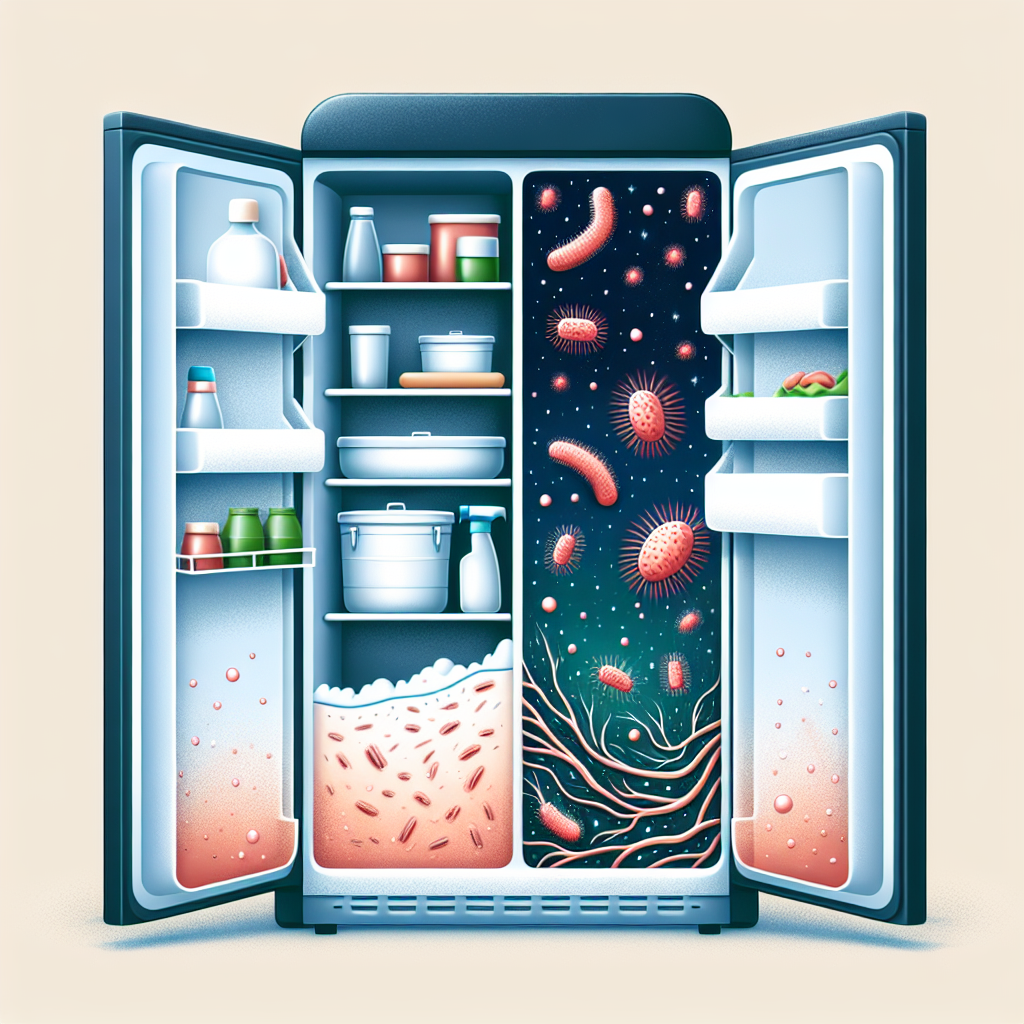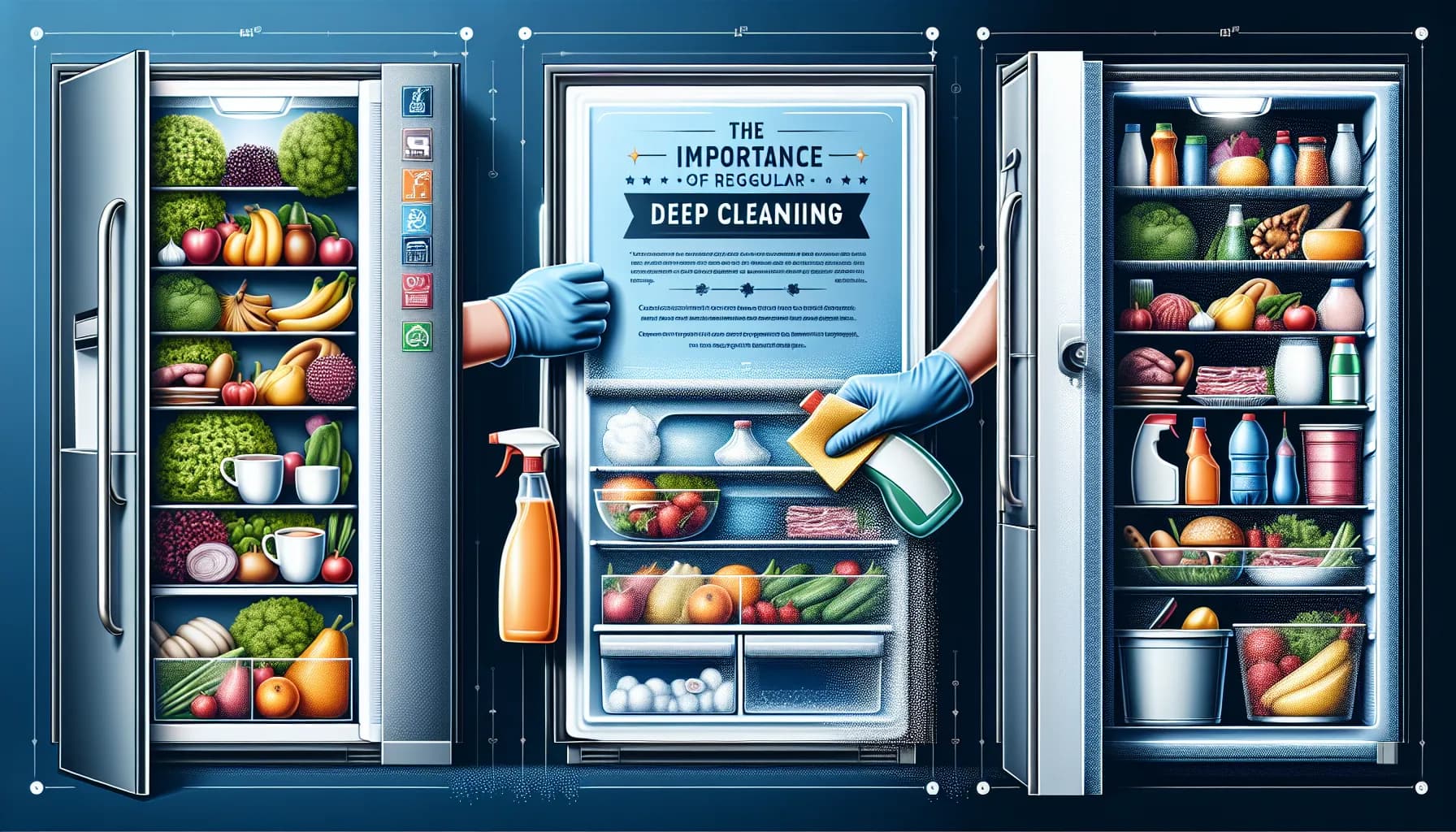Regular cleaning of your fridge is more than just a matter of aesthetics. It’s essential for food safety and hygiene. The refrigerator is a breeding ground for bacteria and other microbes due to its moist, cool environment. Neglecting regular deep cleaning can lead to food contamination, causing foodborne illnesses and infections.
Even if you’re careful not to spill anything and you use airtight containers, bacteria can still find their way into your fridge. They can come from the packages of food you buy, from your hands, or even from the air. Once inside, these bacteria can multiply and contaminate your food. Regular deep cleaning helps to keep the bacterial load in check, reducing the risk of food contamination.
Apart from the risk of foodborne illnesses, a dirty fridge can also lead to other issues like bad odors and inefficient energy usage. When food spills and residues are left uncleaned, they can create unpleasant odors that can affect the taste and quality of other foods stored in the fridge. Moreover, when the condenser coils of your fridge are covered with dust and grime, it can force your fridge to work harder to maintain the desired temperature, leading to higher energy consumption. Regular deep cleaning ensures your fridge remains odor-free and energy-efficient.
The Impact of a Dirty Fridge on Your Health

A dirty fridge isn’t just unsightly - it can be a real health hazard. Foodborne illnesses are often caused by bacteria and other pathogens that can thrive in a poorly maintained fridge. These can cause symptoms ranging from mild discomfort to severe health problems, depending on the type of pathogen and the individual’s immune response.
Bacteria such as Salmonella, E. coli, and Listeria are common culprits of foodborne illnesses and can be found in a dirty fridge. These bacteria can contaminate your food and cause symptoms like diarrhea, vomiting, and fever. Regular deep cleaning of your fridge is crucial to minimize the risk of these foodborne illnesses.
Apart from bacteria, molds can also grow in your fridge, especially in areas where there is spilled food or drink. Some types of mold can produce toxins that can cause allergic reactions or respiratory problems when ingested or inhaled. Regular deep cleaning helps to prevent mold growth, ensuring your fridge remains safe and healthy for food storage.
How Often Should You Deep Clean Your Fridge
While it’s necessary to clean your fridge regularly, you might be wondering how often you should be doing a deep clean. As a rule of thumb, you should aim to deep clean your fridge once every three months. This involves removing all the food items, cleaning all the shelves and drawers, and sanitizing all surfaces.
However, the frequency of deep cleaning can also depend on other factors. For instance, if there are spills, strong odors, or a high volume of food turnover, you may need to deep clean your fridge more frequently. It’s crucial to assess the condition of your fridge regularly and adjust your cleaning schedule accordingly.
If you notice any signs of mold growth, bad odors, or visible dirt or grime, it’s a clear indication that it’s time for a deep clean. Staying on top of your fridge cleaning not only ensures the safety of your food but also prolongs the lifespan of your fridge.
Step-by-Step Guide to Deep Cleaning Your Fridge

Deep cleaning your fridge may seem like a daunting task, but with the right approach, it can be done efficiently and effectively. Here’s a detailed, step-by-step guide to help you:
-
Start by unplugging your fridge. This will not only save energy but also make the cleaning process safer.
-
Remove all the food items. Check the expiry dates and discard any expired or spoiled food.
-
Take out all removable parts like shelves and drawers. These parts can be cleaned separately for thoroughness.
-
Prepare a cleaning solution. A mixture of water and baking soda makes a good cleaning solution that can effectively remove stains and odors.
-
Clean the interior of the fridge. Use a cloth or sponge dipped in the cleaning solution to wipe the inside of the fridge. For tough stains, a toothbrush can be used.
-
Clean the shelves and drawers. These can be washed with warm soapy water, rinsed, and then dried before putting them back in the fridge.
-
Clean the exterior of the fridge. Don’t forget the door handles and the top of the fridge.
-
Plug the fridge back in. Wait until it reaches the correct temperature before restocking your food items.
Remember, deep cleaning your fridge isn’t just about making it look clean, it’s about ensuring it’s hygienically clean to prevent food contamination.
Essential Cleaning Supplies for Your Fridge
When it comes to deep cleaning your fridge, using the right supplies can make the process easier and more effective. Here are some essential items you will need:
-
Baking soda: This is a safe, non-toxic cleaner that can effectively remove stains and odors.
-
White vinegar: It’s a great natural disinfectant that can kill most bacteria and molds.
-
Microfiber cloths: These are ideal for cleaning as they can pick up even the smallest particles of dirt and bacteria.
-
A toothbrush: This can be used to clean hard-to-reach areas or to scrub away tough stains.
-
A bucket and warm water: For making your cleaning solution and for rinsing your cloth or sponge.
Using non-toxic, food-safe cleaning products is important as harsh chemicals can contaminate your food and potentially harm your health.
Tips for Maintaining a Clean Fridge Between Deep Cleans
Maintaining a clean fridge between deep cleans is just as important as the deep cleans themselves. Here are some tips to help you keep your fridge clean and fresh:
-
Wipe up spills immediately. This will prevent them from hardening and becoming difficult to remove later.
-
Check for expired food regularly. Expired food can contaminate other food items and can cause bad odors.
-
Use fridge liners or mats. These can catch spills and are easy to remove and clean.
Practicing these habits will not only make your deep cleaning sessions easier but also help to extend the time between them.
The Role of Organization in Keeping Your Fridge Clean

Keeping your fridge organized is a key aspect of maintaining its cleanliness. An organized fridge makes it easier to spot spills or leaks and allows for better airflow, which helps your fridge maintain its temperature more efficiently.
Some tips for effective fridge organization include:
-
Use clear containers. These allow you to see what’s inside without having to open them, reducing the chance of forgotten leftovers.
-
Designate areas for specific types of food. For example, keep dairy products together, produce together, and so on. This not only makes things easier to find but can also prevent cross-contamination.
-
Keep frequently used items at eye level. This reduces the chance of items being forgotten at the back of the fridge.
Maintaining a clean, well-organized fridge not only improves its efficiency but also extends its lifespan, saving you money in the long run.
The Benefits of Regular Deep Cleaning for Your Fridge
Regular deep cleaning offers numerous benefits, from improved food safety to better energy efficiency. A clean fridge is less likely to harbor harmful bacteria and molds, reducing the risk of foodborne illnesses. It also runs more efficiently, saving you money on your energy bills.
Moreover, regular deep cleaning can extend the lifespan of your fridge. Dirt and grime can cause parts of your fridge to wear out faster, leading to costly repairs or even the need for a replacement. Regular cleaning can help prevent these issues, making your fridge last longer.
Lastly, maintaining a clean, well-organized fridge can give you peace of mind. You can rest assured knowing that your food is stored in a safe, hygienic environment. Plus, there’s the satisfaction of seeing a clean, sparkling fridge every time you open the door.

